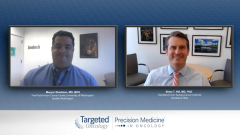
CD19-Targeted mAbs in R/R DLBCL Using Tafasitamab
Dr Mazyar Shadman and Dr Brian T. Hill focus on CD19 being targeted in monoclonal antibody therapy options for relapsed/refractory diffuse large B-cell lymphoma, specifically tafasitamab.
Episodes in this series

Mazyar Shadman, MD, MPH: We have other agents that can potentially target CD19 and are approved for second-line therapy, and those are monoclonal antibodies targeting CD19.
It’s nice. We talked about polatuzumab-vedotin as an antibody-drug conjugate targeting CD79b. How about tafasitamab? That’s an anti-CD19 antibody, a humanized 1 with engineered Fc part, and of course targeting CD19 and encouraging single-agent activity in relapsed/refractory large cell lymphoma and indolent lymphomas that led to the study that used it in combination with lenalidomide. Of course, lenalidomide is a drug that we’ve been using on and off for large cell lymphoma with its impact on T cells and NK [natural killer] cells, both activation and expansion, of course with some direct cell death effects.
The combination was studied in the relapsed large cell lymphoma setting. Maybe we should talk about that study, the L-MIND study. We recently just had some long-term follow-up at ASCO [American Society of Clinical Oncology Annual Meeting], and the paper published very recently. What are your thoughts on the L-MIND study and the patient population? We can talk about the results too.
Brian T. Hill, MD, PhD: The L-MIND study was a large phase 2 single-arm clinical trial of lenalidomide in combination with tafasitamab, which is an anti-CD19 monoclonal antibody without any conjugation or additional components. The study enrolled patients with relapsed diffuse large B-cell lymphoma. There was significant activity in terms of the overall response rate, but what was noteworthy is in the patients who do respond, which is in the 40% range for CRs [complete responses]. The durability of the response was quite impressive. Even 2 years out, the majority of patients who achieved CR are without progression. At that point, they’re just getting tafasitamab every 2 weeks, so 2 doses a month of IV [intravenous] infusion. The tolerability of the regimen is very favorable, except for the things related to lenalidomide, which the audience is probably familiar with in terms of cytopenias, thrombosis risk, sometimes rash, neuropathy. But those things can usually be managed by dose reduction, and it’s not clear that you always need very high doses of lenalidomide to achieve response.
I’m encouraged by the published data. There’s some possibility that refractory patients may not respond well because they were excluded from the trials. If you were refractory, you couldn’t go on the L-MIND trial. That’s still an unmet need. As many things we’re seeing now, we sometimes learn more about these drugs from the real world than we do from the registration trial. We’ll see. I’m curious to see what your experience has been so far.
Mazyar Shadman, MD, MPH: It’s very similar. Just to remind the audience of the treatment schedule, the tafasitamab antibody for the first 3 cycles is given on day 1, 8, 15, and 22. In the first cycle there’s a base for those as well. Starting between cycles 4 and 12, it becomes every-2-weeks therapy. In the study, lenalidomide was given for the first 12 months at 25 mg, 21 of 28 days, and then continued until progression, with the antibody beyond cycle 12. Especially in patients who had a complete response that was 40%, the duration of response was really promising, and it was reached until the median follow-up. They had the 3-year follow-up recently published and presented, and the overall progression-free survival is around a year. But in patients who responded, for CR and PR [partial response], the median duration of response was about 44 months.
When I think about this treatment, in large cell lymphoma we’re not used to having maintenance-type therapies. We’re used to going for a CR, doing a transplant—maybe auto but sometimes allogeneic transplant—or debulking patients to get them to CAR [chimeric antigen receptor] T-cell therapy as a definitive treatment to get into a CR. That’s probably still the case and a strategy. But it’s nice to see a different type of treatment for patients who, for whatever reason, are not eligible for transplant or immunotherapy.
I can share my point of view. In a second or third line, I’d still try to get patients to CAR T if they’re eligible because the onetime therapy, the controlled treatment for a fixed duration and then giving a patient the chance of 30%, 40% long-term remission, is something that I’d like to offer my patient. But I really look at the combo lenalidomide-tafasitamab as a very attractive 1 for patients who, for whatever reason, don’t get to cellular therapy or cellular therapy fails them. How do you sequence these treatments, especially CAR T?
Brian T. Hill, MD, PhD: I agree that if you can get to what we think is probably curative therapy with CAR T, that should be the goal. But it’s not always attainable for a variety of reasons, particularly in an older- patient population, where you’re a little worried about the ability of the patient to safely go through CAR T-cell treatment. The L-MIND data suggest that you may be able to achieve pretty similar outcomes with the appropriately selected patient population, particularly if you know that they’re responding and you may not need to move on to CAR T.
This transcript has been edited for clarity.








































